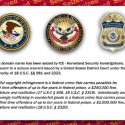My essay last week for Slate.com (the title I proposed is above, but it must have been too “punny” for the editors) generated a lot of feedback, for which I’m always grateful, even when it’s hostile and ad hominem. Which much of it was.
The piece argues generally that when it comes to the Internet, a disruptive technology if ever there was one, the best course of action for traditional, terrestrial governments intent on “saving” or otherwise regulating digital life is to try as much as possible to restrain themselves. Or as they say to new interns in the operating room, “Don’t just do something. Stand there.”
This is not an argument in favor of anarchy, or even more generally for social Darwinism. I have something much more practical in mind. Disruptive technologies, by definition, do not operate within the “normal science” of those areas of life they impact. Its problems can’t be solved by reference to existing systems and institutions. In the case of the Internet, that’s pretty much all aspects of life, including regulation. Continue reading →
 I reported for CNET yesterday on highlights from the State of The Net 2011 conference. Though I didn’t attend last year’s event, I suspect much of the conversation hasn’t changed.
I reported for CNET yesterday on highlights from the State of The Net 2011 conference. Though I didn’t attend last year’s event, I suspect much of the conversation hasn’t changed.
For an event that took place nearly a month after the FCC’s “final” vote on net neutrality, the issue seems not to have quieted down in the least. A fiery speech from Congresswoman Martha Blackburn promised a “Congressional hurricane” in response to the FCC’s perceived ultra vires decision to regulate where Congress has refused to give it authority, a view supported by House and Senate counsel who spoke later in the day. Continue reading →
 This is Part IV of a five-part commentary on the FCC’s Dec. 23, 2010 “Open Internet” Report and Order.
This is Part IV of a five-part commentary on the FCC’s Dec. 23, 2010 “Open Internet” Report and Order.
Part I looked at the remarkably weak justification the majority gave for issuing the new rules.
Part II explored the likely costs of the rules, particularly the undiscussed costs of enforcement that will be borne by the agency and accused broadband access providers, regardless of the merits. (See Adam Thierer’s post on the first attenuated claim of violation, raised before the rules even take effect.)
Part III compared the final text of the rules to earlier drafts and alternative proposals, tracing the Commission’s changing and sometimes contradictory reasoning over the last year.
Part IV, (this part), looks at the many exceptions and carve-outs from the rules, and what, taken together, they say about the majority’s dogged determination to see the Internet as it was and not as it is or will become.
Part V will review the legal basis on which the majority rests its authority for the rules, likely to be challenged in court.
What does an Open Internet mean?
The idea of the “open Internet” is relatively simple: consumers of broadband Internet access should have the ability to surf the web as they please and enjoy the content of their choice, without interference by access providers who may have financial or other anti-competitive reasons to shape or limit that access. Continue reading →

In Part I of this analysis of the FCC’s Report and Order on “Preserving the Open Internet,” I reviewed the Commission’s justification for regulating broadband providers. In Part II, I looked at the likely costs of the order, in particular the hidden costs of enforcement. In this part, I compare the text of the final rules with earlier versions. Next, I’ll look at some of the exceptions and caveats to the rules—and what they say about the true purpose of the regulations
In the end, the FCC voted to approve three new rules that apply to broadband Internet providers. One (§8.3) requires broadband access providers to disclose their network management practices to consumers. The second One (§8.4) prohibits blocking of content, applications, services, and non-harmful devices. The third One (§8.5) forbids fixed broadband providers (cable and telephone, e.g.) from “unreasonable” discrimination in transmitting lawful network traffic to a consumer.
There has of course been a great deal of commentary and criticism of the final rules, much of it reaching fevered pitch before the text was even made public. At one extreme, advocates for stronger rules have rejected the new rules as meaningless, as “fake net neutrality,” “not neutrality,” or the latest evidence that the FCC has been captured by the industries it regulates. On the other end, critics decry the new rules as a government takeover of the Internet, censorship, and a dangerous and unnecessary interference with a healthy digital economy. (I agree with that last one.)
One thing that has not been seriously discussed, however, is just how little the final text differs from the rules originally proposed by the FCC in October, 2009. Indeed, many of those critical of the weakness of the final rules seem to forget their enthusiasm for the initial draft, which in key respects has not changed at all in the intervening year of comments, conferences, hearings, and litigation. Continue reading →
 Every once and awhile it’s worth taking a step back and looking at the long view of how Internet policy developments have unfolded and consider where they might be heading next. We’ve reached such a moment as it pertains to efforts to police the Internet for copyright piracy, objectionable online content, privacy violations, and cybersecurity. We’re at an interesting crossroads in this regard since the prospects for successful cracking down on copyright piracy and pornography appear grim. Seemingly every effort that has been tried has failed. The Net is awash in online porn and pirated content. I am not expressing a normative position on this, rather, I’m just stating what now seems to be commonly accepted fact.
Every once and awhile it’s worth taking a step back and looking at the long view of how Internet policy developments have unfolded and consider where they might be heading next. We’ve reached such a moment as it pertains to efforts to police the Internet for copyright piracy, objectionable online content, privacy violations, and cybersecurity. We’re at an interesting crossroads in this regard since the prospects for successful cracking down on copyright piracy and pornography appear grim. Seemingly every effort that has been tried has failed. The Net is awash in online porn and pirated content. I am not expressing a normative position on this, rather, I’m just stating what now seems to be commonly accepted fact.
In the meantime, the United States is in the process of creating new information control regimes and this time its access to personal information and cybersecurity that are the focus of regulatory efforts. The goal of the privacy-related regulatory efforts is to help Netizens better protect their privacy in online environments and stop the “arms race” of escalating technological capabilities. The goal of cybersecurity efforts is to make digital networks and systems more secure or, more profoundly as we see in the Wikileaks case, it is to bottle up state secrets.
These efforts are also likely to fail. Simply stated, it’s a nightmare to bottle-up information once it’s out there. Continue reading →
 I was quoted this morning in Sara Jerome’s story for The Hill on the weekend seizures of domain names the government believes are selling black market, counterfeit, or copyright infringing goods.
I was quoted this morning in Sara Jerome’s story for The Hill on the weekend seizures of domain names the government believes are selling black market, counterfeit, or copyright infringing goods.
The seizures take place in the context of an on-going investigation where prosecutors make purchases from the sites and then determine that the goods violate trademarks or copyrights or both.
Several reports, including from CNET, The Washington Post and Techdirt, wonder how it is the government can seize a domain name without a trial and, indeed, without even giving notice to the registered owners.
The short answer is the federal civil forfeiture law, which has been the subject of increasing criticism unrelated to Internet issues. (See http://law.jrank.org/pages/1231/Forfeiture-Constitutional-challenges.html for a good synopsis of recent challenges, most of which fail.) Continue reading →
On November 18, the Senate Judiciary Committee unanimously approved the “Combating Online Infringements and Counterfeits Act” (COICA). The bill would enable the U.S. Attorney General to obtain a court order disabling access to web domains that are “dedicated to infringing activities.”
These “rogue websites” are a real problem, as the website Fight Online Theft explains, so it’s a good thing that Congress is working to address them. However, some of COICA’s provisions raise profound constitutional concerns, and the bill lacks adequate safeguards to protect against the unwarranted suspension of Internet domain names, as the website Don’t Censor the Net argues. The bill also doesn’t provide a mechanism for website operators targeted by the Attorney General to defend their site in an adversary judicial proceeding. This week, a group of over 40 law professors submitted a letter to the U.S. Senate arguing that COICA, in its current form, suffers from “egregious Constitutional infirmities.”
To address these concerns, CEI is urging Congress to amend COICA to provide for more robust safeguards, including: Continue reading →
 When the only tool you have is a hammer, as the old cliché goes, everything looks like a nail.
When the only tool you have is a hammer, as the old cliché goes, everything looks like a nail.
Net neutrality, as I first wrote in 2006, is a complicated issue at the accident-prone intersection of technology and policy. But some of its most determined—one might say desperate—proponents are increasingly anxious to simplify the problem into political slogans with no melody and sound bites with no nutritional value. Even as—perhaps precisely because—a “win-win-win” compromise seems imminent, the rhetorical excess is being amplified. The feedback is deafening.
In one of the most bizarre efforts yet to make everything be about net neutrality, Public Knowledge issued several statements this week “condemning” Fox’s decision to prohibit access to its online programming from Cablevision internet users. In doing so, the organization claims, Fox has committed “the grossest violations of the open Internet committed by a U.S. company.”
This despite the fact that the open Internet rules (pick whatever version you like) apply only to Internet access providers. Indeed, the rules are understood principally as a protection for content providers. You know, like Fox. Continue reading →
Last week, I had the pleasure of discussing net neutrality with James Boyle, a Duke Law Professor and the co-founder of the Center for the Study of the Public Domain, and Paul Jones, the director of ibiblio, on WUNC’s The State of Things radio program. Our hour-long discussion touched on a number of important tech policy topics, and I highly recommend giving the show a listen (download the MP3 here) if you’re interested in hearing the insights of two very thoughtful scholars and critics of cyber-libertarianism.
I’m a big admirer of Boyle and Jones, who’ve both done a lot of excellent work studying copyright and public domain in the information age. While I don’t share their views on the merits of net neutrality regulation — or, perhaps, of government regulation in general — there’s much common ground between us on many issues, including intellectual property, free speech, and government surveillance.


For folks who don’t want to spend an hour listening to our discussion, I’ve typed up a brief summary of the questions we attempted to tackle in our discussion and the various arguments we raised. My apologies if I’ve mischaracterized any arguments or statements — if you want to know what was actually said, go listen to the whole interview!
Continue reading →

My article for CNET this morning, “The end of software ownership…and why to smile,” looks at the important decision a few weeks ago in the Ninth Circuit copyright case, Vernor v. Autodesk. (See also excellent blog posts on Eric Goldman’s blog. Unfortunately these posts didn’t run until after I’d finished the CNET piece.)
The CNET article took the provocative position that Vernor signals the eventual (perhaps imminent) end to the brief history of users “owning” “copies” of software that they “buy,” replacing the regime of ownership with one of rental. And, perhaps more controversially still, I try to make the case that such a dramatic change is in fact not, as most commentators of the decision have concluded, a terrible loss for consumers but a liberating victory.
I’ll let the CNET article speak for itself. Here I want to make a somewhat different point about the case, which is that the “ownership” regime was always an aberration, the result of an unfortunate need to rely on media to distribute code (until the Internet) coupled with a very bad decision back in 1976 to extend copyright protection to software in the first place.
Continue reading →










 The Technology Liberation Front is the tech policy blog dedicated to keeping politicians' hands off the 'net and everything else related to technology.
The Technology Liberation Front is the tech policy blog dedicated to keeping politicians' hands off the 'net and everything else related to technology.